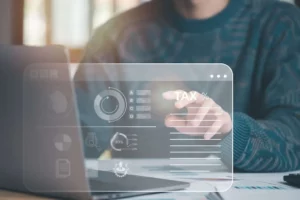Have you ever struggled to collect data manually and was overwhelmed with endless report spreadsheets? The intricacies involved in reporting may be quite daunting. The record to report (R2R) procedure comes to rescue the day for CFOs, accounting teams, and business owners across various industries looking to enhance their financial reporting process. Ultimately, it decreases mistakes and eliminates time-consuming manual labor. Today, we’ll figure out what is record to report and consider how it spruces reporting.
What is Record to Report?
The record to report process underpins an organization’s entire financial reporting and analysis function. It represents a critical, multi-step approach to capturing, validating, and presenting financial data in a standardized and auditable format.
R2R is your go-to choice if you want to assess financial state, mark trends, and measure progress. Thanks to such a proactive approach, you can make informed decisions about investments and growth based on profitability, cash flow, and resource allocation.
So, what does the R2R consist of? Let’s look at the primary elements:
- Data Entry: The cornerstone is accurate transaction record keeping. It’s vital to avoid making errors here, as they influence the reliability of reports used for critical decisions.
- Accounts Payable & Payroll: If you efficiently manage payments to vendors and employees, your firm will run without a hitch. Timely payments to your business partners are a key to good relationships. At the same time, accurate payroll fosters employee morale.
- Reconciliation: When you regularly align company ledgers with bank statements and credit cards reports, you get a safeguard. The process helps identify and rectify any discrepancies that may arise.
- Closing Process: You should put together financial statements, such as balance sheets and income statements. This gives a genuine and truthful financial picture of your company.
The record to report assists with data analysis in addition to reporting. Sorting through the data can help you identify potential bottlenecks, uncover financial details, and seize chances for improvement.
The Record to Report Process Steps
After we’ve figured out the basics, let’s find out the fundamental record to report process steps. The following actions are crucial:
- Data Entry and Initial Recording. You must first gather financial data from subsidiary ledgers, supplemental systems, and principal accounting records. Since the data is the foundation for the next stages, accuracy and comprehensiveness are essential.
- Accounts Payable and Payroll Processing. Successful handling of payroll and accounts payable (AP) is essential if you want a seamless R2R flow. Simplifying these procedures permits prompt and precise documentation of financial transactions. The result? Downstream reporting and reconciliation go without a hitch.
- Reconciliation and Compliance Checks. Account reconciliation may be difficult and time-consuming. Thus, the best course of action is to align the procedures and make use of automated solutions.
- Closing Process and Financial Statement Preparation. Here, you finalize the firm’s financial records for a specific time. It comprises compiling the data into key financial statements like income statements and balance sheets.
In a nutshell, the R2R takes raw data, cleanses it through checks and balances, and transforms it into insightful reports. It encourages firms to obtain their financial purposes.
Implementing Automation in the Record to Report Cycle
R2R process automation is here to make your life easier. It automates process-inherent repetitive and manual processes. Now, you don’t require manual involvement and lower the likelihood of mistakes. Moreover, it can spread to various data management functions. You can also assign the tasks of data collection and reconciliation to automated software.
It’s all about working smarter, not harder. The perks of such a step into digitization go beyond. Automated controls can be implemented to ensure compliance with internal policies, financial regulations, and reporting standards. This can include automated validation checks, audit trails, and approval workflows.
Optimizing Cloud Computing in R2R
Cloud computing has become a big deal in bookkeeping. Cloud-based enterprise resource planning (ERP) tools grow to be more important as they offer scalability and ease of use. Here’s how cloud ERPs empower your R2R journey:
- Real-Time Data Access: Finance teams may react quickly to altering market conditions based on the latest financial info. Real-time data mitigates the risk of mistakes arising from outdated or siloed information.
- Enhanced Scalability: Cloud-based systems automatically scale to accommodate increasing data needs. They reduce IT infrastructure costs and simplify R2R processes for ventures of all sizes.
- Collaboration: Your staff can access and share data seamlessly — it is a collaborative R2R environment. Teams work on the same data simultaneously and expedite various tasks.
It’s crucial to remember that the R2R process shouldn’t be a one-time fix. Think of it as an ongoing process. Continuous improvement is a driver of success in this case. How can you foster it? First, establish clear, consistent procedures for all accounting tasks. Naming conventions, journal entry criteria, and assigned roles should be unified and clear to all staff.
Second, train your team on the latest tools and best practices. Invest in staff development to guarantee they’re equipped to keep up with industry trends. This, coupled with the strategic integration of new technologies like automation software and cloud-based platforms, can significantly streamline tasks.
Finally, regular check-ins are the key. Conduct periodic audits with stakeholders to gather feedback on the financial reports. It helps identify any missing information and improve future reporting.
Closing
The record to report process is the backbone of any healthy financial system. It empowers firms to make informed decisions and achieve financial goals. If you embrace best practices like automation and cloud computing, you may succeed in the competitive landscape. These technologies not only save time and resources, but also minimize errors and ensure compliance with regulations.
Ready to take your R2R process to the next level? Contact BooksTime directly for personalized services and explore our extensive resources on finance and accounting best practices. We can help you optimize your R2R process and unlock the full potential of your financial data.


















